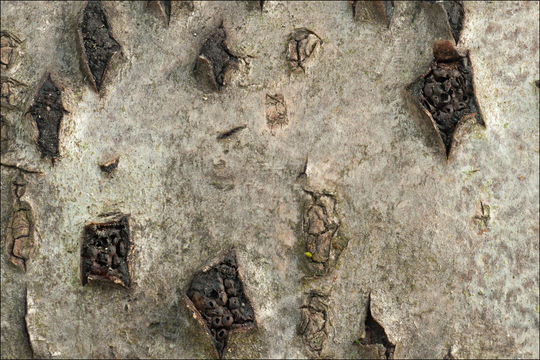Image of Diatrypella favacea (Fr.) Ces. & De Not. 1863

Description:
Slo.: brezova predirnica - syn.: Sphaeria favacea Fr., Diatrype favacea Fr., Microstoma favaceum (Fr.) Auersw., Diatrypella verruciformis (Ehrh.) Nke. - Habitat: Light wood and bushes on the edge of a small alpine pasture, moderately inclined mountain slope, southeast aspect; shallow, skeletal, colluvial, calcareous ground; mostly sunny, exposed to direct rain, average precipitations ~ 3.000 mm/year, average temperature 7-9 deg C, elevation 615 m (2.020 feet), alpine phytogeographical region. Substratum: Dead, still standing, almost horizontally positioned branch of Corylus avellana. Comments: Taxonomy of genus Diatrypella is not yet settled on species level, even not on genus level. Consequently the descriptions in literature of the habit and host(s) of the species under the name Diatrypella favacea vary widely. There are mainly two approaches; 'lumpers' consider Diatrypella favacea in broader sense and consider different spore sizes of finds on different hosts as insignificant, while 'splitters' find these differences significant (among other traits) and recognize several host specific species. According to them this find would clearly be Diatrypella verruciformis (Ehrh.) Nke., which grows on Corylus sp. only. They consider Diatrypella favacea a species bound exclusively on Betula sp.. I follow Index Fungorum where these taxa (and others) are considered synonyms. Stromata 2-5.5 mm in diameter, ostioles of mature stromata small, barely visible, when old and weathered much larger; stromata mostly on the upper side of the branch; branch decayed, about 5 cm in diameter; attempt to extract pigments using 5% KOH was negative. Spores smooth, curved. Dimensions: 6,2 [7,2 ; 7,6] 8,6 x 1,4 [1,7 ; 1,8] 2,1 microns; Q = 3,2 [4 ; 4,3] 5,1 ; N = 40 ; C = 95%; Me = 7,4 x 1,8 microns; Qe = 4,2. Asci many spored. Olympus, NEA 100x/1.25, magnification 1.000 x, oil; fresh material, in water. AmScope MA500 digital camera. Herbarium: Mycotheca and lichen herbarium (LJU-Li) of Slovenian Forestry Institute, Vena pot 2, Ljubljana, Index Herbariorum LJF Ref.: (1) Personal communication with Mr. Osieck Eduard, AscoFrance. Many thanks for the links to relevant literature. (2) J. Breitenbach, F. Kraenzlin, Eds., Fungi of Switzerland, Vol.1. Verlag Mykologia (1984), p 282. (3) G. Medardi, Atlante fotografico degli Ascomiceti d'Italia, A.M.B. Centro Studi Micologici (2012) (in Italian with English keys), p 327. (4) Vasilyeva, L.N. & S.L. Stephenson, Pyrenomycetes of the Great Smoky Mountains National Park. II. Cryptovalsa Ces. et De Not. and Diatrypella (Ces. et De Not.) Nitschke (Diatrypaceae), Fungal Diversity (2005), 19: 189-200. http://www.fungaldiversity.org/fdp/sfdp/19-12.pdf (5) http://www.pilzbestimmer.de/Detailed/17417.html (6) Glawe, D.A. & J.D. Rogers, Diatrypaceae in the Pacific Northwest, Mycotaxon (1984), 20: 401-460; available at Cyberliber http://www.cybertruffle.org.uk/cyberliber/59575/0020/002/0430.htm (7) Croxall 1950 (Studies on British Pyrenomycetes. III. The British species of the genus Diatrypella Cesati & De Notaris, Trans. Brit. Mycol. Soc. (1950), 33(1/2): 45-72. (8) https://www.verspreidingsatlas.nl/0593010 (see tab 'artikelen').
Included On The Following Pages:
- Life (creatures)
- Cellular (cellular organisms)
- Eukaryota (eukaryotes)
- Opisthokonta (opisthokonts)
- Nucletmycea
- Fungi (mushrooms, lichens, molds, yeasts and relatives)
- Dikarya
- Ascomycota (sac fungi)
- Sordariomycetes
- Xylariales
- Diatrypaceae
- Diatrypella
- Diatrypella favacea
This image is not featured in any collections.
Source Information
- license
- cc-by-nc-sa-3.0
- copyright
- 2017 Dr. Amadej Trnkoczy
- photographer
- Dr. Amadej Trnkoczy
- original
- original media file
- visit source
- partner site
- CalPhotos
- ID


